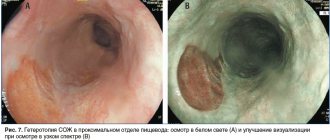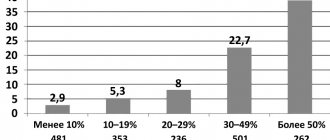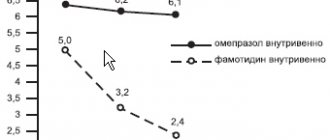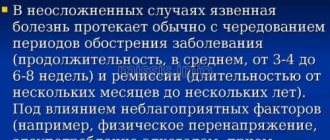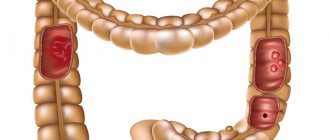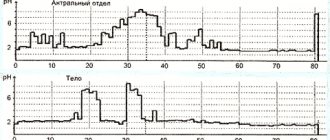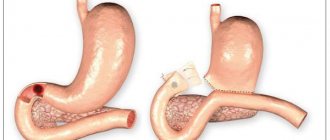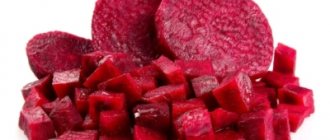Diagnostics
- Clinical blood test. Allows you to detect anemia.
- Coprogram. Detects hidden blood and undigested dietary fiber.
- Feces for occult blood. An express method to detect bleeding in the gastrointestinal tract.
- FGDS. The “gold standard” for diagnostics, allowing visualization of mucosal defects. Allows you to take material for a biopsy and check the cellular composition and identify the cause of the pathology.
- Ultrasound of the abdominal organs. Allows you to identify inflammation of the parenchymal organs of the gastrointestinal tract.
Causes
- Helicobacter pylori. The bacterium can penetrate from the lumen of the stomach into the area of the duodenum with chyme; it can damage the mucous membrane, provoking the development of erosive gastroduodenitis.
- Medicines. Long-term, uncontrolled use of steroidal and non-steroidal anti-inflammatory drugs leads to a weakening of the protective properties of the mucous membrane and cell destruction.
- Gastroesophageal reflux disease. Weakness of the gastrointestinal sphincter leads to the fact that chyme constantly moves from the stomach to the intestines, and since the acidity in different parts of the gastrointestinal tract is different, the risk of inflammation increases.
- Pancreatitis or Zollinger-Ellison syndrome (development of a tumor of the pancreas, resulting in increased enzyme production). Since the pancreas produces an increased amount of enzymes, they are capable of damaging the body’s own cells, and the process of self-digestion occurs.
- Smoking. Leads to disruption of the trophism of the gastrointestinal tract, a decrease in the local immune response, and destruction of the mucous protective film of the gastrointestinal tract.
- Nervous overstrain. Stress and depression lead to an increase in stomach acidity, the buffer system that protects the duodenum and creates an alkaline environment in it is depleted, and erosions form.
- Errors in diet. Overeating, consumption of preservatives, spicy, fatty and fried foods, unbalanced with nutrients, increases the load on the gastrointestinal tract.
- Autoimmune diseases. Crohn's disease or ulcerative colitis contributes to the destruction of the gastrointestinal mucosa under the influence of its own immune mechanisms.
- Oncopathology. The development of cancer contributes to the formation of erosions.
Treatment
Pathology therapy must be comprehensive. It includes diet, medication and, if necessary, surgical correction.
Be sure to read:
Intestinal diseases: symptoms of pathologies, diagnosis and treatment
Medical products (drugs, medicines, vitamins, dietary supplements) are mentioned for informational purposes only. We strongly do not recommend using them without a doctor's prescription. We recommend reading: “Why can’t you take medications without a doctor’s prescription?”
Diet
The diet for erosive gastritis should be as gentle as possible for the stomach and intestines. Basic principles:
- Thermally processed food. All dishes must be cooked: boiled, steamed or baked.
- Dishes are served cold or warm. During the period of bleeding, preference is given to cold liquid foods, which promote reflex vasoconstriction and reduce bleeding. Hot food can cause bleeding by dilating blood vessels.
- Shredded food. Helps facilitate digestion. Preferably ground through a sieve, crushed in a blender, through a meat grinder.
| Recommended Products | Not Recommended Products |
|
|
Drugs
- Antacids (Almagel, Phosphalugel). Promote the formation of a protective film on the mucous membrane of the stomach and duodenum and reduce further damage.
- Proton pump or H2-histamine receptor inhibitors. Helps reduce the acidity of gastric juice and reduce its damaging effect on the intestinal mucosa.
- Antibacterial agents. In the presence of infectious inflammation (Helicobacter infection).
- Hemostatic agents. In case of severe bleeding, aminocaproic acid is used locally; drugs such as Etamsylate and Dicinone act systemically.
- Asymptomatic therapy. Correction of vitamin deficiencies, pain syndrome (with antispasmodics) and so on is carried out.
Be sure to read:
pH-metry of the stomach: preparation, implementation and interpretation of diagnostic results
Surgery
Used in case of severe bleeding. Very rarely, they resort to removing part of the intestines or stomach - only with extensive defects.
The most commonly used local treatment is cauterization of the erosive area during fibrogastroduodenoscopy. The minimally invasive technique is effective and allows you to quickly stop bleeding and speed up regenerative processes.
Traditional methods
The main purpose of folk methods is to protect the mucous membrane from the effects of physical or chemical damaging factors and saturate the body with useful substances.
These actions allow you to activate regeneration and speed up the healing process. Use:
- natural oils: sea buckthorn, linseed, olive;
- fish fat;
- potato broth.
Symptoms
Intestinal manifestations
- Pain syndrome. The localization, intensity, time of appearance and nature of pain depend on the location of the mucosal defect. With erosion located above the papilla of the common bile duct, pain occurs in the upper part of the epigastrium, 1.5-2 hours after eating, they are cramping in nature, corresponding to a peristaltic wave, and end after the next snack. With postbulbar injuries, the patient is bothered by constant aching pain in the umbilical region, in the epigastrium the patient complains of heaviness.
- Dyspeptic phenomena. Manifest in the form of belching, often sour, heartburn. Flatulence may form as a result of insufficient digestion of food in the duodenum. This leads to the development of putrefactive and fermentation processes in the underlying parts of the intestine. Patients often complain of nausea, but they rarely vomit and the urge is false.
- Stool instability. Most often, patients with duodenal erosion have a tendency to diarrhea. This happens for two reasons: the food is not fermented enough and the absorption of complex compounds is difficult.
- Melena. Black stools happen often. This is due to bleeding of the damaged mucosa when erosions reach the choroid plexus and damage the capillary wall. The larger the area and depth of the damage, the more pronounced the symptom will be. With minor damage, the test for occult blood shows a positive result, and red blood cells and hemoglobin are detected in the coprogram.
Extraintestinal manifestations
- Violation of vagal tone. The vagus nerve innervates the area of the duodenum; if the mucous membrane is damaged, its effect may be inhibited. This manifests itself in the form of a decrease in heartbeat, increased sweating, most often manifested in the form of hyperhidrosis of the palms and feet.
- Asthenia. It is the result of insufficient digestion, which leads to a deficiency of nutrients and a decrease in calories entering the body. The patient complains of weakness, lethargy, apathy, and drowsiness.
- Anemia. It is the result of several factors. Firstly, iron is absorbed in the intestine and when the duodenum is not functioning properly, iron deficiency anemia is formed. Secondly, constant bleeding leads to the formation of posthemorrhagic iron deficiency anemia.
Be sure to read:
Large duodenal (Vater) papilla: location, functions and diseases of the structure
